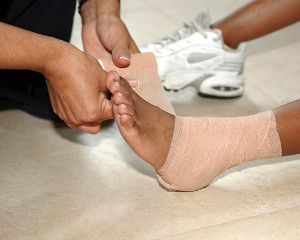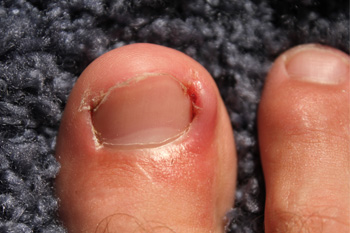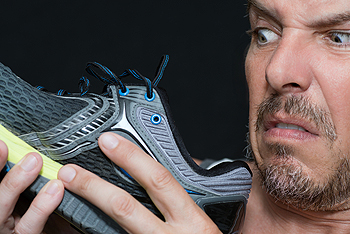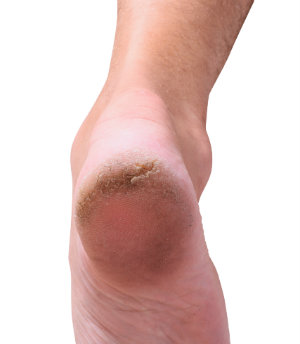Items filtered by date: January 2019
Ankle Sprains and the Healing Process
 An ankle sprain is one of the more common ankle injuries that many people may incur over the course of their lifetime. It may typically occur when the ankle rolls inward, which may be a result of stepping suddenly off a curb or tripping unexpectedly. Some of the unpleasant symptoms that may be experienced with ankle sprains may be severe pain when walking is attempted, swelling, in addition to bruising. It may help to protect the ankle by laying or sitting, limit your walking or use crutches, and applying pressure to the affected ankle by wrapping it with an elastic bandage. Taking over the counter pain medication may aid in alleviating a portion of the pain and discomfort, despite the fact it is ineffective in accelerating the healing process. It is important to return to normal activities gradually, and this may give the ankle ample time to heal completely. If you have injured your ankle and believe it may be sprained, it is advised that you seek the counsel of a podiatrist who can guide you to proper treatment procedures.
An ankle sprain is one of the more common ankle injuries that many people may incur over the course of their lifetime. It may typically occur when the ankle rolls inward, which may be a result of stepping suddenly off a curb or tripping unexpectedly. Some of the unpleasant symptoms that may be experienced with ankle sprains may be severe pain when walking is attempted, swelling, in addition to bruising. It may help to protect the ankle by laying or sitting, limit your walking or use crutches, and applying pressure to the affected ankle by wrapping it with an elastic bandage. Taking over the counter pain medication may aid in alleviating a portion of the pain and discomfort, despite the fact it is ineffective in accelerating the healing process. It is important to return to normal activities gradually, and this may give the ankle ample time to heal completely. If you have injured your ankle and believe it may be sprained, it is advised that you seek the counsel of a podiatrist who can guide you to proper treatment procedures.
Although ankle sprains are common, they aren’t always minor injuries. If you need your ankle injury looked at, contact Dr. Joshua David Scoll from Pennsylvania. Our doctor can provide the care you need to keep you pain-free and on your feet.
How Does an Ankle Sprain Occur?
Ankle sprains are the result of a tear in the ligaments within the ankle. These injuries may happen when you make a rapid shifting movement while your foot is planted. A less common way to sprain your ankle is when your ankle rolls inward while your foot turns outward.
What Are the Symptoms?
- Pain at the sight of the tear
- Bruising/Swelling
- Ankle area is tender to touch
- In severe cases, may hear/feel something tear
- Skin discoloration
Preventing a Sprain
- Wearing appropriate shoes for the occasion
- Stretching before exercises and sports
- Knowing your limits
Treatment of a Sprain
In many cases, the RICE method (Rest, Ice, Compression, and Elevate) is used to treat ankle sprains. However, you should see a podiatrist to see which treatment option would work best with your injury. In severe cases, surgery may be required.
It is important to ask your doctor about rehab options after you receive treatment for your injury. Stretching, strength training, and balance exercises may help the ankle heal while also preventing further injury.
If you have any questions, please feel free to contact one of our offices located in Philadelphia, Bensalem, and Fairless Hills, PA . We offer the newest diagnostic and treatment technologies for all your foot care needs.
Noticable Signs You May Have an Ingrown Toenail
 Our feet endure stress during most of the day as we accomplish daily activities. This may come from standing or walking for extended periods of time, and our feet will often tell us if something is amiss. One of these uncomfortable conditions is known as ingrown toenails, and this may often produce severe pain and discomfort. This occurs when the nail on the big toe begins to grow into the skin next to it. Reasons why this may occur may be from improperly trimming the toenails or wearing shoes that fit incorrectly. There are noticeable symptoms that typically accompany this condition, including redness and inflammation at the end of the toe, pain when pressure is applied, bleeding, or in severe cases, pus may drain from the affected area. Research has shown the importance in obtaining prompt treatment, which may avoid a painful infection. If you have developed an ingrown toenail, it is advised to consult with a podiatrist who can guide you to a correct course of action.
Our feet endure stress during most of the day as we accomplish daily activities. This may come from standing or walking for extended periods of time, and our feet will often tell us if something is amiss. One of these uncomfortable conditions is known as ingrown toenails, and this may often produce severe pain and discomfort. This occurs when the nail on the big toe begins to grow into the skin next to it. Reasons why this may occur may be from improperly trimming the toenails or wearing shoes that fit incorrectly. There are noticeable symptoms that typically accompany this condition, including redness and inflammation at the end of the toe, pain when pressure is applied, bleeding, or in severe cases, pus may drain from the affected area. Research has shown the importance in obtaining prompt treatment, which may avoid a painful infection. If you have developed an ingrown toenail, it is advised to consult with a podiatrist who can guide you to a correct course of action.
Ingrown toenails may initially present themselves as a minor discomfort, but they may progress into an infection in the skin without proper treatment. For more information about ingrown toenails, contact Dr. Joshua David Scoll of Pennsylvania. Our doctor can provide the care you need to keep you pain-free and on your feet.
Ingrown Toenails
Ingrown toenails are caused when the corner or side of a toenail grows into the soft flesh surrounding it. They often result in redness, swelling, pain, and in some cases, infection. This condition typically affects the big toe and may recur if it is not treated properly.
Causes
- Improper toenail trimming
- Genetics
- Improper shoe fitting
- Injury from pedicures or nail picking
- Abnormal gait
- Poor hygiene
You are more likely to develop an ingrown toenail if you are obese, have diabetes, arthritis, or have any fungal infection in your nails. Additionally, people who have foot or toe deformities are at a higher risk of developing an ingrown toenail.
Symptoms
Some symptoms of ingrown toenails are redness, swelling, and pain. In rare cases, there may be a yellowish drainage coming from the nail.
Treatment
Ignoring an ingrown toenail can have serious complications. Infections of the nail border can progress to a deeper soft-tissue infection, which can then turn into a bone infection. You should always speak with your podiatrist if you suspect you have an ingrown toenail, especially if you have diabetes or poor circulation.
If you have any questions, please feel free to contact one of our offices located in Philadelphia, Bensalem, and Fairless Hills, PA . We offer the newest diagnostic and treatment technologies for all your foot care needs.
Plantar Hyperhidrosis May Be Uncomfortable
 If your feet sweat often and excessively, you may have a condition that is referred to as plantar hyperhidrosis. Patients who are afflicted with this condition may notice their shoes and socks are wet and soggy the majority of the time, in addition to leaving damp imprints of their feet as a result of the excess moisture. Patients who are afflicted with this condition may find moderate relief by wearing shoe inserts daily, which may help in absorbing moisture. Many patients may find it advantageous to use powder in their socks, and this may aid in soaking up any excess moisture. Additionally, drying your shoes out at the end of the day may aid eliminating a portion of the sweat that has accumulated. If you suffer from plantar hyperhidrosis, it is suggested to speak with a podiatrist who can inform you of correct treatment options.
If your feet sweat often and excessively, you may have a condition that is referred to as plantar hyperhidrosis. Patients who are afflicted with this condition may notice their shoes and socks are wet and soggy the majority of the time, in addition to leaving damp imprints of their feet as a result of the excess moisture. Patients who are afflicted with this condition may find moderate relief by wearing shoe inserts daily, which may help in absorbing moisture. Many patients may find it advantageous to use powder in their socks, and this may aid in soaking up any excess moisture. Additionally, drying your shoes out at the end of the day may aid eliminating a portion of the sweat that has accumulated. If you suffer from plantar hyperhidrosis, it is suggested to speak with a podiatrist who can inform you of correct treatment options.
If you are suffering from hyperhidrosis contact Dr. Joshua David Scoll of Pennsylvania. Our doctor can provide the care you need to attend to all of your foot and ankle needs.
Hyperhidrosis of the Feet
Hyperhidrosis is a rare disorder that can cause people to have excessive sweating of their feet. This can usually occur all on its own without rigorous activity involved. People who suffer from hyperhidrosis may also experience sweaty palms.
Although it is said that sweating is a healthy process meant to cool down the body temperature and to maintain a proper internal temperature, hyperhidrosis may prove to be a huge hindrance on a person’s everyday life.
Plantar hyperhidrosis is considered to be the main form of hyperhidrosis. Secondary hyperhidrosis can refer to sweating that occurs in areas other than the feet or hands and armpits. Often this may be a sign of it being related to another medical condition such as menopause, hyperthyroidism and even Parkinson’s disease.
In order to alleviate this condition, it is important to see your doctor so that they may prescribe the necessary medications so that you can begin to live a normal life again. If this is left untreated, it is said that it will persist throughout an individual’s life.
A last resort approach would be surgery, but it is best to speak with your doctor to find out what may be the best treatment for you.
If you have any questions please feel free to contact one of our offices located in Philadelphia, Bensalem, and Fairless Hills, PA . We offer the newest diagnostic and treatment technologies for all your foot and ankle needs.
Proper Footwear and Cracked Heels
 Research has shown the medical condition that is referred to as cracked heels may originate from wearing shoes with an open back, flip flops, or from standing for the majority of the day. The skin on the feet may become dry and hardened, and cracks or fissures may develop from the pressure the feet must endure. The style of walking may play a significant role in the formation of cracked heels, and this may include people whose heels bear the brunt of the body’s weight. Research has shown it may be helpful to stretch the Achilles tendon, and this may aid in even distribution of the weight. Additionally, it may be helpful to wash and dry the feet thoroughly followed by utilizing a good moisturizer. If you are afflicted with cracked heels, it is advised to seek the counsel of a podiatrist who can offer proper guidance in maintaining good foot health.
Research has shown the medical condition that is referred to as cracked heels may originate from wearing shoes with an open back, flip flops, or from standing for the majority of the day. The skin on the feet may become dry and hardened, and cracks or fissures may develop from the pressure the feet must endure. The style of walking may play a significant role in the formation of cracked heels, and this may include people whose heels bear the brunt of the body’s weight. Research has shown it may be helpful to stretch the Achilles tendon, and this may aid in even distribution of the weight. Additionally, it may be helpful to wash and dry the feet thoroughly followed by utilizing a good moisturizer. If you are afflicted with cracked heels, it is advised to seek the counsel of a podiatrist who can offer proper guidance in maintaining good foot health.
Cracked heels are unsightly and can cause further damage to your shoes and feet. If you have any concerns, contact Dr. Joshua David Scoll from Pennsylvania. Our doctor can provide the care you need to keep you pain-free and on your feet.
Cracked Heels
Cracked heels appear unappealing and can make it harder for you walk around in sandals. Aside from looking unpleasant, cracked heels can also tear stockings, socks, and wear out your shoes. There are several methods to help restore a cracked heel and prevent further damage.
How Do You Get Them?
Dry skin is the number one culprit in creating cracked heels. Many athletes, walkers, joggers, and even swimmers suffer from cracked heels. Age and skin oil production play a role to getting cracked heels as well.
Promote Healing
Over the counter medicines can help, especially for those that need instant relief or who suffer from chronic dry feet.
Wear Socks – Wearing socks with medicated creams helps lock in moisture.
Moisturizers – Applying both day and night will help alleviate dryness which causes cracking.
Pumice Stones – These exfoliate and remove dead skin, which allows for smoother moisturizer application and better absorption into the skin.
Change in Diet
Eating healthy with a well-balanced diet will give the skin a fresh and radiant look. Your body responds to the kinds of food you ingest. Omega-3 fatty acids and zinc supplements can also revitalize skin tissue.
Most importantly, seek professional help if unsure how to proceed in treating cracked heels. A podiatrist will help you with any questions or information needed.
If you have any questions, please feel free to contact one of our offices located in Philadelphia, Bensalem, and Fairless Hills, PA . We offer the newest diagnostic and treatment technologies for all your foot care needs.
Heel Pain May Develop Gradually
 Research has shown that heel pain is considered to be the most common form of pain in the feet. There may be several reasons why this type of pain may occur, including an injury that has happened to the Achilles tendon, a condition that is referred to as plantar fasciitis, in addition to heel spurs. If this type of pain is caused by an injury, the pain will most likely be sudden and severe. If an injury did not occur, heel pain may be experienced gradually, which may often lead to severe discomfort. A common reason why heel pain begins may be related to the type of shoes that are worn, which may lead to additional foot conditions developing. If you are experiencing any type of heel pain, it is strongly suggested to consult with a podiatrist who can determine the reason for this, and to discuss correct treatment options.
Research has shown that heel pain is considered to be the most common form of pain in the feet. There may be several reasons why this type of pain may occur, including an injury that has happened to the Achilles tendon, a condition that is referred to as plantar fasciitis, in addition to heel spurs. If this type of pain is caused by an injury, the pain will most likely be sudden and severe. If an injury did not occur, heel pain may be experienced gradually, which may often lead to severe discomfort. A common reason why heel pain begins may be related to the type of shoes that are worn, which may lead to additional foot conditions developing. If you are experiencing any type of heel pain, it is strongly suggested to consult with a podiatrist who can determine the reason for this, and to discuss correct treatment options.
Many people suffer from bouts of heel pain. For more information, contact Dr. Joshua David Scoll of Pennsylvania. Our doctor can provide the care you need to keep you pain-free and on your feet.
Causes of Heel Pain
Heel pain is often associated with plantar fasciitis. The plantar fascia is a band of tissues that extends along the bottom of the foot. A rip or tear in this ligament can cause inflammation of the tissue.
Achilles tendonitis is another cause of heel pain. Inflammation of the Achilles tendon will cause pain from fractures and muscle tearing. Lack of flexibility is also another symptom.
Heel spurs are another cause of pain. When the tissues of the plantar fascia undergo a great deal of stress, it can lead to ligament separation from the heel bone, causing heel spurs.
Why Might Heel Pain Occur?
- Wearing ill-fitting shoes
- Wearing non-supportive shoes
- Weight change
- Excessive running
Treatments
Heel pain should be treated as soon as possible for immediate results. Keeping your feet in a stress-free environment will help. If you suffer from Achilles tendonitis or plantar fasciitis, applying ice will reduce the swelling. Stretching before an exercise like running will help the muscles. Using all these tips will help make heel pain a condition of the past.
If you have any questions please contact one of our offices located in Philadelphia, Bensalem, and Fairless Hills, PA . We offer the newest diagnostic and treatment technologies for all your foot and ankle needs.
